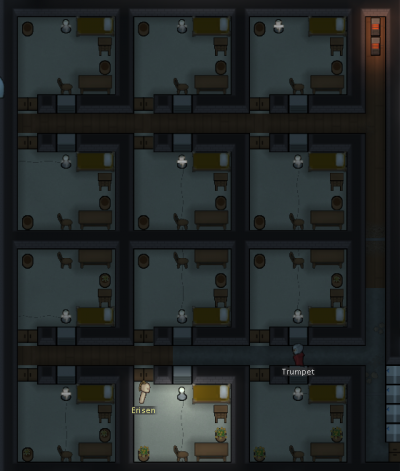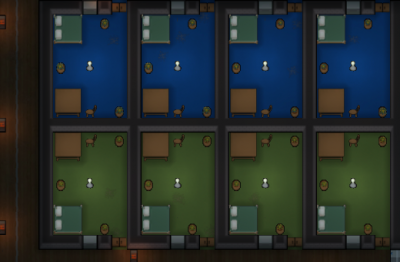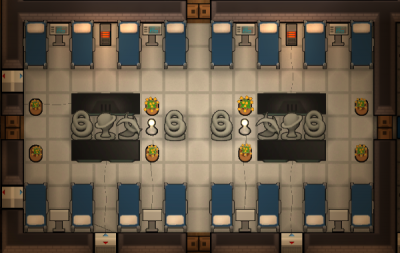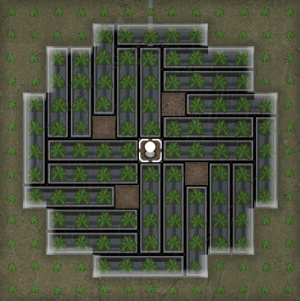Colony Building Guide
This guide is the ultimate go-to guide to building your base, for all stages of the game.
Base Types
There are different ways to build your base.
Superstructure base
To build a superstructure base, put everything in 1 large building rather than separate it into multiple small parts.
This is a common method to build bases, and is generally the recommended way to do so.
Pros
- Convenient
- Saves building materials and some space
- More resistant against toxic fallout
Cons
- Fires can spread all over the base if flammable materials are used
Mountain base
For mountainous maps where you have less space to build, you can opt to dig inside the mountains instead.
Pros
- Good temperature control
- Easy to defend
- Immune to mortar strikes
Cons
- Infestations can happen within base
Base Structures
Different structures suit the different needs of your colony.
Dining room
Dining rooms, at its simplest, are simply rooms where you put tables and chairs for colonists to dine in.
A dining room should be built as close as possible near the freezer/ food storage so your colonists will actually use the dining room, instead of eating on the floor of the storage, giving them a -3 mood debuff. This is especially true for larger freezers, in which colonists retrieving food from the far end may simply give up searching for a table and eat on the floor.
For increased mood buffs, decorate your dining room using sculptures, plant pots or quality furniture.
Freezer
Freezers are vital to food preservation.
Consider making a dedicated one or two tile large stockpile with a very high priority at the front of your freezer which only allows meals. This way, your meals will always be right at the front of your possibly very large freezer. Also, if you make two more stockpiles at the front of your freezer for meat and veggies, your cook won't have to run as far for ingredients, allowing him to make meals faster (colonists assigned to hauling will move ingredients from the back of the freezer to the front).
Expect your dining room to be pretty crowded during meal times, especially after a party or marriage ceremony, so have enough chairs for at least half your colony. Colonists will also hang out in the dining room if you set them to do so, occupying seats.
Rec room
You should have a wide variety of joy sources so your colonists don't get bored repeatedly throwing horseshoes at a pin, or wandering around aimlessly. Putting all of them in a room also provides a mood bonus after a colonist uses the facilities inside, depending on the impressiveness of the room.
In early game all you need is to have horseshoes pin somewhere in the colony, and colonists will proceed to use it when they are bored.
Once you reach midgame, you can afford more joy facilities such as chess tables or billiards tables, or Tube televisions, which provide different kinds of joy for additional variety. In addition, you can also obtain additional joy sources from exotic goods traders, such as telescopes or flatscreen and megascreen televisions, which are more joyful than the craftable tube television.
Similarly to the dining room, decorating it can improve the mood bonus from using the room.
Barracks
You will need somewhere indoors for your colonists to sleep early-game. It should be one of your starting projects.
Build beds for your colonists to sleep in as colonists dislike sleeping on the ground.
Bedrooms
Since colonists don't like to sleep together, once you have the manpower and materials you should upgrade to individual bedrooms for each colonist. However it usually isn't worth it until you can guarantee that you won't build Awful or Dull bedrooms.
For better comfort and rest effectiveness, make sure the beds are of Normal quality or above, otherwise deconstruct and try again until you get it. If you have lovers or couples you will need a double bed so they can sleep together.
You should also have a table in the bedrooms, as colonists often carry food with them, and without a table, colonists will resort to eating their breakfast on the floor. Also turn off the 'Gather Spot' option otherwise colonists will go off into the bedrooms to chill off on their own, most likely in someone else's bedroom (though nobody seems to care).
Bedrooms should ideally be at least be 3x5; this gives you enough space to squeeze in a bed and a table, without making the colonist feel cramped. At the beginning, you only need it to be 2x2, enough to fit a bed with a little room to spare.
Hospital
Dedicated hospitals are more of a mid-game thing when you have enough resources to build the specialized equipment used in them.
Hospitals should have sterile tiles as flooring as they provide a slight cleanliness buff that can increase surgery success chance and reduce wound infection chance.
Hospitals should be built somewhere where colonists can quickly bring their downed comrades to treat them. Keep doors open, or use autodoors so they don't obstruct colonists' access. If you need to you can also build a mini-hospital or clinic elsewhere in the base.
Hospital beds provide a boost to treatment quality and immunity gain speed, meaning that your colonists will gain immunity to diseases faster, hence recovering faster and are less likely to die. You should have these instead of regular beds if available. Colonists resting in a hospital bed also heal faster than they do when on a normal bed.
The vitals monitor brings even better boosts to treatment and immunity gain, so once you've researched them it's recommended that you put them down near your hospital beds.
Store your medicine in your hospital using shelves so your doctors can quickly grab them to patch up colonists before they bleed to death. Sometimes just that little distance can already make a difference between life and death.
Decorating hospitals to make them beautiful can give colonists inside a great mood boost (max +15, plus impressive room stats). This is good, especially considering that some colonists will stay in the hospital for a long time (such as the severely injured, incapacitated or sick).
To provide joy, you may also build or buy televisions to install into your hospitals. Patients lying in hospital beds within the viewing area will watch TV to entertain themselves when they are bored, and you won't need colonists coming to cheer them up as their only joy source.
If you have even more resources you can build a separate room for each colonist. While they don't mind sleeping with others in a hospital, they do get disturbed by them walking around, and dirt can more easily affect cleanliness as well.
Operating theater
You can build a separate room to accommodate colonists who will undergo surgery, to make sure that colonists undergo medical operations in the cleanest of places.
Your operating theater should be forbidden at all cases except when someone is about to have surgery. This prevents colonists from tracking dirt or blood into it, staining it.
Laboratory
You may want to have a room dedicated to research, with hi-tech research benches, multi-analyzers to increase research speed and unlock new research, as well as sterile tiles to keep the room clean, increasing research speed. For even better cleanliness, restrict the lab to your researchers and janitors only, reducing traffic and hence the amount of dirt in the room.
Prison

Prison barracks
In the early game you can simply convert any existing ruins into a makeshift prison barracks, or build a simple prison hut, which you use to hold all prisoners you capture. Try not to build it too far away from your main structures, otherwise it becomes harder to catch escaping prisoners.
You should include tables and chairs for prisoners to use.
Prison cells
Like colonists, prisoners will also suffer from the mood penalties associated with being kept together in a prison barracks. In addition, prison breaks are also more serious should they happen, for every prisoner locked up in the same room will simultaneously break out, while prisoners in different cells may choose not to join. Thus, you should keep them separated.
Each cell should have a table with a chair, a bed, and a light source. This is the bare minimum you need for a prisoner to be decently kept. Decorating the cell and making them bigger also increase mood bonuses for easier recruitment. They can't use any joy items put in the cell, nor do they have a joy need, so don't bother with joy items unless you want to make the cell more impressive.
Prisons should have doors facing towards your base, so escaping prisoners will go towards your base instead of away, giving your wardens more time to deal with the break.
Holding cell
A larger cell with more beds. It should be only be used when your prison cells are overflowing. Put your less important prisoners inside them while assigning your more valuable prisoners into the cells.
Flooring outside
To reduce the amount of dirt inside your colony buildings, put any kind of flooring covering places where colonists frequently go. This reduces the amount of dirt formed as well as causes dirt to be left outside where it does not look as bad.
Backup
There are many types of ways you can set up buildings on your map to possibly save your colonists' lives in dire situations:
- Shelters: Building small rooms with an emergency food and wood supply can save your colonists from enraged animals. Thick enough walls can stop raiders from killing your colonists hiding inside.
- Nutrient paste dispensers: When food is running low or you forecast that it will, a paste dispenser can significantly slow down food consumption by efficiently converting raw foods into nutrient paste.
Production
You will also need various buildings to produce or manufacture the stuff that your colonists need.
Crop fields
Crop fields are rather simple; just set up a growing zone, designate the desired plant type and growers will automatically go and grow the plants.
You will need to keep animals out, whether or not they are tamed. Exclude these areas out of the allowed areas of animals, and build walls to keep out wild animals.
Greenhouses
Enclosed areas that grow crops with the aid of temperature control, sun lamps and possibly hydroponics basins. They allow you to continue growing crops regardless of soil or weather conditions.
Workshop
Workshops are places where you put all your crafting stations and benches, probably including your cooking stoves as well. You should put them near your warehouse so your colonists can spend less time hauling the needed resources to the workshop for crafting. Also remember to put chairs of any sort at the interaction spot so your colonists won't have to keep standing while crafting.
Putting all the crafting stations inside the warehouse isn't recommended despite the convenience, as colonists do not enjoy the sight of random objects laying around. This lowers their beauty opinion of their surroundings, in turn giving mood penalties. You should however put crafting materials near the workshop for quicker retrieval.
It is an excellent idea to put decorations such as sculptures inside the workshop, as a beautiful environment gives up to +15 mood, improving colonists' productivity.
Kitchen
You should build your kitchen near your cold storage, just as you build the workshop near your warehouse.
Kitchens should only have cooking stoves, and sterile tiles for flooring to reduce the chance of food poisoning. The butcher table is best put elsewhere due to the heavy cleanliness debuff.
Shelves or small stockpiles can really improve cooking efficiency when placed right next to your stove, set to accept only berries and vegetables as these do not spoil in a matter of days, unlike meat which should always be in the freezer.
Power
Solar power
Solar generators provide power only during the day. It provides 1700W, quite a decent figure, but still not to be fully relied on.
It can be used to
Wind power
Wind turbines provide unstable power throughout the day. It can provide up to 3000W, but it usually gives less than that.
It requires plenty of open space for maximum efficiency, and any obstacles can easily reduce efficiency. To prevent trees from growing and obstructing the turbines, put down floors, grow crops underneath the turbines or fill in the gaps with solar generators.
Fueled generation
You can get the fueled generator which runs on wood (or also chemfuel in Alpha 18), constantly providing 1000W of power. It is a good idea to have some of these as a backup power source.
Geothermal power
Geothermal generators constantly gives 3600W of power after being built on a steam geyser without requiring fuel. It is an important source of power from mid-game onward, as it is constant and high-powered.
Research is required to unlock it, and the generator itself is quite costly so it's best left to midgame. However, once researched and built you can have a constant power supply, and with 5 generators on the map you can sustain a basic mid-sized colony.
Make sure your geothermal generators and their connecting conduits are well-protected as they often have to be placed far from base.
It is possible to rush the research for geothermal power, though you should be careful not to neglect other more important research projects.
Power storage
You will need batteries to store power if you're using unstable power supplies such as wind or solar power. If possible, connect them to the grid via switches, so you can shut off unneeded batteries to reduce the impact of short circuits.
Power network
It's not a good idea to have just 1 conduit spanning the entirety of your base- while it saves materials, short circuits or other events can cripple your power supply.
Instead, build an extensive network so the grid continues to function even if there is a break somewhere in the network.
Emergency power
Some events will cause you to lose power if you are unprepared. Some colonies rely on wind or solar power to power everything, and eventually every colony with electricity will suffer from a fault conduit explosion, also show as 'Zzzt...' Both cases will cause you to lose power, whether it's not enough wind or sun, or an explosion. Raider attacking and destroying power conduits connected to power generators can sever power from the colony, reducing the power available.
- Backup batteries: Always have spare power stores, such as multiple battery systems with switches. Only connect extra when they are about to run out, or are charging.
- Backup generators: Have some fueled generators that you bring online only if there's not enough power in the colony. This can allow your backup batteries to discharge slower, or even recharge. If they are turned off they will not consume fuel.
Defenses
Unless you're playing on Peaceful difficulty, you will eventually encounter major threats, so you will need to prepare defenses for that.
The greatest advantage on your side is cover. While enemies are hiding behind rock chunks, you have sandbags and walls on your side, giving you a significant upper hand.
You can also choose to build turrets if you have unlocked them. They are essential if you don't have enough colonists to defend against raids, most typically the start of the Rich Explorer scenario.
Temperature control
Room should have its temperature regulated by some method or another, so as to keep a comfortable temperature for colonists to live in, and protect them from extreme temperature conditions such as heat waves, cold snaps or simply the outdoors ambient temperature.
Large rooms such as your dining room or rec room should have their own heaters and coolers. If they are interconnected you may want to open doors for faster colonist access and temperature exchange. If you choose to do so, remember to close doors if a fire breaks out in the room.
Smaller rooms such as your bedrooms should be thermally connected to a larger central space through vents. Your heaters and coolers should be all placed outside the bedrooms. This reduces the number of heaters and coolers you need to build while keeping your bedrooms at a comfy temperature at the same time.
Keep in mind that you will also need to be prepared in case of a freak temperature event such as heat waves or cold snaps. Without enough temperature devices rooms can get uncomfortably cold or hot, and in severe cases begin to cause hypothermia or heatstroke.
Cooler column
Instead of hanging your coolers out in the open, you can place them all inside, with the hot end facing an at least 2x2 unroofed area area where the heat vents out into the open. This helps fortify your base against enemy raids, as coolers have low health and can be destroyed in a single explosion, opening an easy way into into your base.
Best used for freezers to keep cool as most cases don't call for that many coolers (8 can surround a 2x2 unroofed space). For other situations you can simply put a few walls in front of the freezer to block explosions without blocking the exhaust vent.
Temporary temperature control
If your regular heaters or coolers aren't doing the trick, or you're a tribe without the ability to harness electricity yet, you can use campfires or passive coolers to cool down your base. Both have the same effect as their powered variants, except they are rather limited in their available temperature range- campfires can't heat above 30°C while passive coolers can't cool below 15°C.
These are best used to keep colonists comfortable during heat waves or cold snaps. If you always encounter uncomfortable temperatures during summer or winter then it's time to upgrade your heaters or cooler system.


